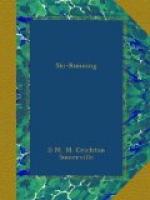Even a bad runner will find that he can do marvels as the snow seems literally to help him in all his experiments. I have known a day when a blinding blizzard has started blowing the snow into my face and I have run fast along the bottom of a valley with my eyes shut. The Skis kept to the lowest line and ran safely and steadily through this powder snow at a low gradient. It is not suggested that blind running should be indulged in as a rule and I only quote this case to show how helpful is good powder snow.
The Telemark is the usual turn in soft snow. Christiania and jump turns can also be used by people who are proficient and strong, but they require both skill and strength.
Soft snow is usually found on North slopes or at the bottom of shady valleys or even behind any ridge which protects it from the sun or wind. Also among trees which shelter it. Tracks ruin it in time so that it is usually wise to sidle off the track and try new snow beside it.
Luckily for the experienced runner, most beginners usually behave rather like sheep, preferring tracks to exploring on their own. The result is that perfect snow can often be found alongside the beaten track, and when this gets spoilt, it is only necessary to go a little further afield in order to get a good run. Then, as more and more people beat down the track it becomes hard and very amusing running can be had there.
Hard snow is of two types—a beaten track or a hard crust where the sun has melted the surface and the frost at night has frozen it, so that it will bear the weight of the Ski-runner. When this is really solid enough to allow of side-slipping and stem, or Christiania turns, it is very trustworthy and easy to negotiate. At first, however, it intimidates the beginner, because it is very fast. As time goes on and he becomes accustomed to the skid and rattle of hard snow, he will find that his horror turns into pleasure because he can trust it. The Nursery slopes become hard after two or three days and will provide useful experience for coping with such snow on a run.
The lifted stem and Christiania are the best turns on hard snow. A Telemark is apt to skid too much.
Crust is the bugbear of all runners and is out and away the most difficult to tackle. It may be hard, and then with nothing apparent on the surface to warn you, the Skis break through and catch in the crust and down you go. When crust is about, let someone else lead, and then profit by his experience.
There are many forms of crust, all of which may be met on the same run, and when wind has been at work, there may be crust on North slopes and not on South. After rain too, when the surface has been soaked and a frost follows, crust will be found everywhere.
Sticky snow is usually due to the effect of the sun or to Fohn wind or thaw. It is easily coped with by proper waxing of the running surfaces, but the sudden sticking of the skis, which have been running well over wet snow in the open, when they get into cold powder snow under trees or in shadow, is very disconcerting.




